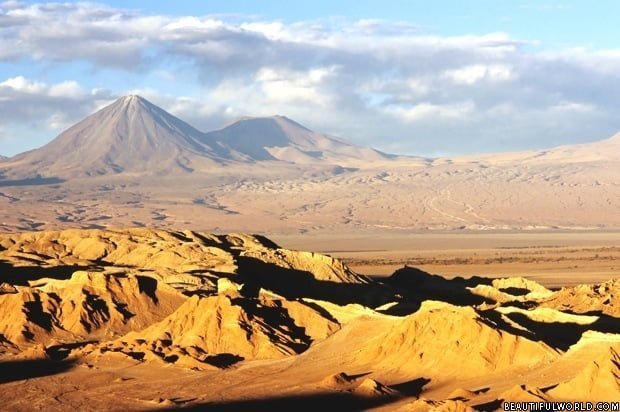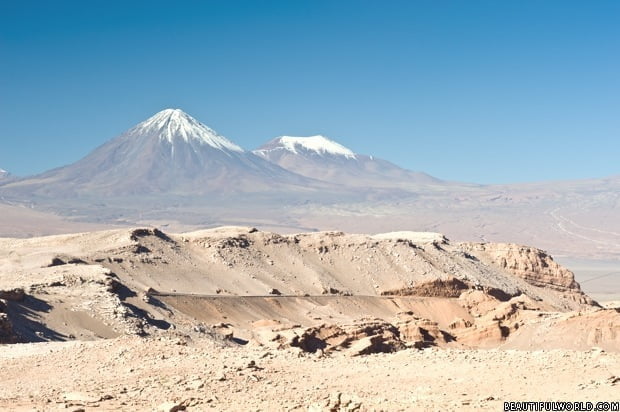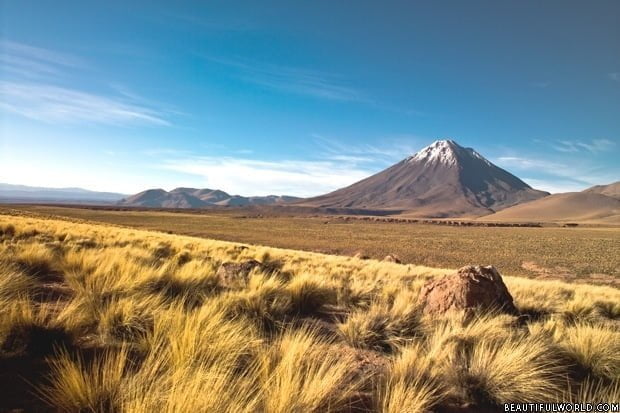The Atacama Desert covers a total area of 40,541 sq. mi (105,000 sq. km), stretching 600mi (1000km) from southern Peru into northern Chile. Officially the driest place on Earth, it receives almost no rainfall whatsoever. In fact, it is so dry that some weather stations in the desert have never recorded a single drop of rain. As a result of these harsh conditions, plant and animal life is almost non-existent, particularly in the lower Atacama Desert. The northern coastal areas, however, do receive a little more rainfall, and as a result, are less arid.

Why is the Atacama Desert so dry?
Three different reasons contribute to the Atacama Desert being the driest place on earth. The first reason is that the desert sits on the wrong side of the Andes with regards to prevailing winds. As pictured above, the prevailing south-east trade winds carrying moist air are forced to rise. The moisture condenses, and falls on the opposite side of the Andes to the Atacama. This is commonly known as a rain shadow.
The second reason is high air pressure. Essentially, descending air warms up, meaning that any moisture within turns to water vapour (gas, not liquid) as opposed to rain. Finally, the last reason is the cold Humboldt Current from the Pacific Ocean. Any onshore winds are chilled so they are unable to pick up moisture from the ocean. Cumulatively, the effect of the aforementioned three points creates the driest place on earth.
Interesting facts about the Atacama Desert
Soil samples taken from Mars have been identified as being surprisingly similar to those taken from the Atacama Desert. As a result, NASA frequently uses the desert landscape to test its planetary rover vehicles/instruments prior to embarking upon missions to the red planet.
The Chinchorro mummies, found in the Atacama Desert, are the oldest examples of artificially mummified human remains ever discovered. In fact, the oldest Chinchorro mummies predate those found in Egypt by thousands of years.
The temperature in the Atacama Desert can reach highs of around 104°F (40°C) during the dayime, whilst falling to temperatures of 41°F (5°C) or below at night.

The Atacama Desert is 50 times drier than Death Valley. As you would expect, very few animals have been able to successfully adapt and inhabit this barren, dry landscape. The small numbers of insects in the region become the prey of lizards, whilst an occasional bird of prey can be found hunting for prey. Mammals are equally rare, with mice and fox among those you may encounter periodically.
The Atacama Desert is home to the Atacama Crossing endurance race, in which competitors traverse a wide range of terrains, including approximately 11,500ft (3500m) of ascents/descents over a 7-day period. The quickest anyone has completed the feat is 23h 46m, an accolade accomplished by the Spaniard, Vicente Garcia Beneito.
The Atacama Desert contains the world’s largest supply of sodium nitrate, making it a valuable resource. As a result, the area was mined significantly in the 1940’s. Many mining towns have since been abandoned.
Throughout the 1800’s, the Atacama Desert was at the epicenter of a land dispute between Bolivia and Chile. Both nations claimed that they were the rightful owners of the northeastern portion of the desert, leading to the War of the Pacific (1879-1884) breaking out. This area contained highly valuable mineral resources, which the British and Chileans were exploiting for a substantial profit. Chile ultimately emerged as the victor, keeping control of the Atacama Desert in its entirety.
The Atacama ‘Alien’
A tiny humanoid skeleton was discovered in the Atacama desert in 2003. It was only 15cm long and its ribs and head were elongated and narrow which gave it a very strange appearance leading plenty of people to speculate that it had to be an alien. However, DNA and x-ray analysis showed it to be human and quite recent. Some scientists believed it to be the remains of a 6-8 year old child with an as yet unidentified medical condition due to the density of its teeth and other skeletal features. Others argue it is consistent with it being a miscarried or aborted foetus.















This place is crazy dry, i walked just 2 hours in the atacama and drank 3 large bottles of water, be very well prepapred if you go.
Ciao come mai hai camminato due ore nel deserto? X fare foto? O x vedere altro? Mi racconteresti la tua esperienza? Grazie mille
Atacama desert is in Chile, not Argentina
Actually its in both and you will see that it is listed under 4 countries on this site. The Atacama desert spans Chile, Bolivia, Peru and Argentina.
i thougt it was in california
Death Valley is in Eastern California
ikr
its in 4 countries btw
The country is Chile. not Chili.
Of course, you are right, we have fixed this, thank you.
is it a cool or hot desert ???
Both, in the day is hot about 35 c and at night is frezzing cold about -10 c
Thankyou, to whoever made this site, it was really helpful!
This is very helpful for research on the Atacama Desert.
I lived 4 years in the Atacama Dessert outside Antofagasta
We vacationed twice a year seaside in Barquito
A lifetime of experiences
Traded with local natives for woven Goods from llamas.
Fluent in Spanish still
Left the country, afraid government takeover of copper mines where my father was chief accountant.